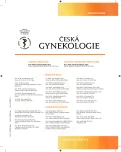Cervical cancer – possibilities of detection of human papillomavirus
Authors:
H. Ondryášová; V. Koudelakova; M. Hajdúch
Authors‘ workplace:
Laboratoř experimentální medicíny, Ústav molekulární a translační medicíny, LF UP a FN, Olomouc, vedoucí doc. MUDr. M. Hajdúch. Ph. D.
Published in:
Ceska Gynekol 2013; 78(3): 289-294
Overview
Objective:
To describe the possibility of detection of HPV DNA in cervical cancer.
Design:
Review.
Setting:
Institute of Molecular and Translational Medicine, Laboratory of Experimental Medicine, Palacky University and University Hospital Olomouc.
Methods:
Human papillomavirus (HPV) is the cause of many cancers, especially cervical cancer. Current cervical cancer screening is based on cytological examination, which is followed by HPV DNA diagnostics only in cases with abnormal results of uncertain significance. Methods used for HPV detection are often based on PCR reaction followed by genotyping (complete or partial). HPV DNA diagnostics isn´t currently included into the primary cervical cancer screening in the Czech Republic although it has higher sensitivity than cytology.
Conclusion:
Inclusion of HPV DNA testing into the primary cervical cancer screening would significantly increase its sensitivity and thus would help to reduce the morbidity and mortality of this disease in Czech population.
Keywords:
human papillomavirus – HPV – cervical carcinoma – cervical cancer screening – cytology – LBC – PCR
Sources
1. Arbyn, M., Anttila, A., Jordan, J., et al. European Guidelines for Quality Assurance in Cervical Cancer Screening. Second ed. – summary document. Ann Oncol, 2010, 21, p. 448–458.
2. Baay, MF., Quint, WG., Koudstaal, J., et al. Comprehensive study of several general and type-specific primer pairs for detection of human papillomavirus DNA by PCR in paraffin-embedded cervical carcinomas. J Clin Microbiol, 1996, 34, p. 745–747.
3. Castle, PE., Gage, JC., Partridge, EE., et al. Human papillomavirus genotypes detected in clinician-collected and self-collected specimens from women living in the Mississippi Delta. BMC Infect Dis, 2013, 13, p. 5.
4. Castle, PE., Stoler, MH., Wright, TC., Jr., et al. Performance of carcinogenic human papillomavirus (HPV) testing and HPV16 or HPV18 genotyping for cervical cancer screening of women aged 25 years and older: a subanalysis of the ATHENA study. Lancet Oncol, 2011, 12, p. 880–890.
5. Chaiwongkot, A., Pientong, C., Ekalaksananan, T., et al. Evaluation of primers and PCR performance on HPV DNA screening in normal and low grade abnormal cervical cells. Asian Pac J Cancer Prev, 2007, 8, p. 279–282.
6. de Sanjose, S., Diaz, M., Castellsague, X., et al. Worldwide prevalence and genotype distribution of cervical human papillomavirus DNA in women with normal cytology: a meta-analysis. Lancet Infect Dis, 2007, 7, p. 453–459.
7. de Sanjose, S., Quint, WG., Alemany, L., et al. Human papillomavirus genotype attribution in invasive cervical cancer: a retrospective cross-sectional worldwide study. Lancet Oncol, 2010, 11, p. 1048–1056.
8. Dillner, J., Rebolj, M., Birembaut, P., et al. Long term predictive values of cytology and human papillomavirus testing in cer-vical cancer screening: joint European cohort study. BMJ, 2008, 337, p. 1754.
9. Dunne, EF., Nielson, CM., Stone, KM., et al. Prevalence of HPV infection among men: A systematic review of the literature.J Infect Dis, 2006, 194, p. 1044–1057.
10. Dušek, L., Mužík, J., Kubásek, M., et al. Epidemiologie zhoubných nádorů v České republice [online]. Masarykova univerzita, [2005], [cit. 2013-3-18]. Dostupný z WWW: http://www.svod.cz. Verze 7.0 [2007], ISSN 1802– 861.
11. Fernandes, JV., Araújo, JMG., Fernandes, TAAM. Biology and natural history of human papillomavirus infection. Open Access J Clin Trials, 2013, 5, p. 1–12.
12. Gibb, RK., Martens, M.G. The impact of liquid-based cytology in decreasing the incidence of cervical cancer. Rev Obstet Gynecol, 2011, 4, p. S2–S11.
13. Hermonat, PL., Han, L., Wendel, PJ., et al. Human papillomavirus is more prevalent in first trimester spontaneously aborted products of conception compared to elective specimens. Virus Genes, 1997, 14, p. 13–17.
14. Jemal, A., Bray, F., Center, MM., et al. Global cancer statistics. CA Cancer J Clin, 2011, 61, p. 69–90.
15. Jeney, C., Takacs, T., Sebe, A., et al. Detection and typing of 46 genital human papillomaviruses by the L1F/L1R primer system based multiplex PCR and hybridization. J Virol Methods, 2007, 140, p. 32–42.
16. Májek, O., Daneš, J., Zavoral, M., et al. Aktuální výsledky programů screeningu zhoubných nádorů. Lékařské listy – Příloha Zdravotnických novin, 2011, 60, p. 5–8.
17. Morris, BJ. Cervical human papillomavirus screening by PCR: advantages of targeting the E6/E7 region. Clin Chem Lab Med, 2005, 43, p. 1171–1177.
18. Munoz, N., Bosch, FX. de, et al. Epidemiologic classification of human papillomavirus types associated with cervical cancer.N Engl J Med, 2003, 348, p. 518–527.
19. Parkin, DM. The global health burden of infection-associated cancers in the year 2002. Int J Cancer, 2006, 118, p. 3030–3044.
20. Solomon, D., Davey, D., Kurman, R., et al. The 2001 Bethesda System: terminology for reporting results of cervical cytology. JAMA, 2002, 287, p. 2114–2119.
21. Stoler, MH., Wright, TC. Jr., Sharma, A., et al. High-risk human papillomavirus testing in women with ASC-US cytology: results from the ATHENA HPV study. Am J Clin Pathol, 2011, 135, p. 468–475.
22. van Baars, R., Bosgraaf, RP., ter Harmsel, BW., et al. Dry storage and transport of a cervicovaginal self-sample by use of the evalyn brush, providing reliable human papillomavirus detection combined with comfort for women. J Clin Microbiol, 2012, 50, p. 3937–3943.
23. Vinokurova, S., Wentzensen, N., Kraus, I., et al. Type-dependent integration frequency of human papillomavirus genomes in cervical lesions. Cancer Res, 2008, 68, p. 307–313.
24. Walboomers, JM., Jacobs, MV., Manos, MM., et al. Human papillomavirus is a necessary cause of invasive cervical cancer worldwide. J Pathol, 1999, 189, p. 12–19.
Labels
Paediatric gynaecology Gynaecology and obstetrics Reproduction medicineArticle was published in
Czech Gynaecology

2013 Issue 3
Most read in this issue
- Intrahepatic cholestasis of pregnancy
- Determination of anti-Müllerian hormone in women
- Antibiotic profylaxis in obstetrics
- Peripartum cardiomyopathy after caesarean section – a case report
